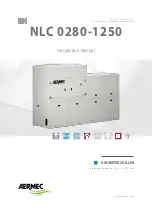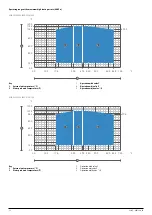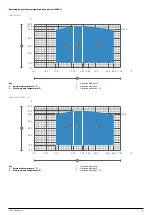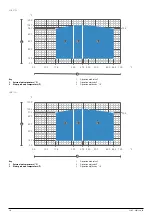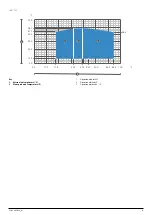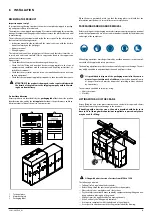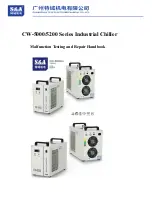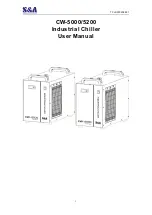
8
22.05 – 4037360_01
check and repair or, if necessary, replace any component or pipe that shows signs of
damage. Use a platform, or suitable scaffolding to work at higher levels.
All the precautions concerning the handling of refrigerant must be observed in ac-
cordance with current regulations.
The overall fire risk assessment at the place of installation (i.e. fire load calculation)
is the responsibility of the user;
Keep fire estinguishers near the machine suitable for putting out fires on electrical
equipment and, for lubricant oil of the compressor and the refrigerant;
PRECAUTIONS CONCERNING THE HYDRAULIC CIRCUIT
Perform the plant connections following the indications provided in the manual:
—
It is necessary to install a water filter and a flow switch on the heat ex-
changers, otherwise the warranty shall be void;
—
During commissioning, it is mandatory to carry out a seal test on the air
of the hydraulic circuit (minimum pressure 36.3 psi and a search for leak-
ages on every joint - e.g. using leak detector foam or soap + water) before
filling it with glycol. This is to avoid the need for corrections due to leaks
caused, for example, during the transportation/handling stage (even
though the circuit is tested before leaving the Aermec factory);
— Do not bend or strike pipes containing pressurised fluids. Do not exceed the
maximum permissible pressure (PS) of the unit's water circuit;
— Before removing elements along the pressurised water circuits, intercept the
concerned section of pipe and release the fluid gradually until the pressure is
balanced with the atmospheric pressure;
— Even with the unit off, prevent the fluid in contact with the heat exchangers
exceed the temperature limits indicated in the documentation and freeze;
— Do not send liquids to the heat exchangers other than water or its mixtures
with ethylene/propylene glycol in concentrations above what is indicated in the
technical documentation;
PRECAUTIONS CONCERNING THE ELECTRICAL CIRCUIT
— Perform the plant connections following the indications provided in this man-
ual;
— Do not use cables with inadequate section or flying connections, not even for
limited periods or emergencies;
— Check the unit is properly earthed before starting it;
— Before opening the electrical panel, disconnect the unit from the mains by
means of the external isolator;
— In case of units with shunt capacitors, wait 3 minutes from when power supply
was disconnected from the unit before accessing inside the electrical panel;
— If the unit has components such as integrated inverters, disconnect the power
supply and wait at least 15 minutes before accessing it for maintenance opera-
tions: the internal components remain energised for this period, generating the
risk of electrocution;
— The safety devices must be maintained efficient and periodically checked as
prescribed by current regulations;
PRECAUTIONS CONCERNING THE COOLING CIRCUIT
— The overall fire risk assessment at the place of installation (i.e. fire load calcula-
tion) is the responsibility of the user;
— Keep fire estinguishers near the machine suitable for putting out fires on elec-
trical equipment and, for lubricant oil of the compressor and the refrigerant;
— The unit contains pressurised refrigerant gas: no operation may be performed
on pressurised equipment except during maintenance, which must be per-
formed by skilled and qualified personnel;
— Perform brazing or welding only on empty pipes and clear of any lubricating
oil residues; do not near flames or other heat sources to the pipes containing
refrigerant fluid;
— Do not work with naked flames near the unit;
— In order to avoid an environmental risk, make sure that any fluid leaks are recov-
ered in suitable devices in compliance with local regulations;
— Do not use your hands to control any refrigerant leaks;
— An accidental release of refrigerant may cause risk of suffocation due to a lack of
oxygen: install the machine in a well ventilated environment in accordance with
EN 378-3 and local regulations currently in force. Those who come into contact
with the machine must be equipped with a leak detector that is calibrated and
validated to reveal any used refrigerant leaks.
— The unit is fitted out with overpressure relief devices (safety valves): in the event
that these devices start, the refrigerant gas is released at high temperature and
high velocity. Prevent the gas flow from harming people or things;
— Install the unit at a distance enough from the exhaust wells;
— Keep all lubricants in properly marked containers. Do not keep flammable liq-
uids near the plant;
PREVENTIONS
— Make sure that the protections of mobile elements are correctly in place before
restarting the unit;
— Fans, motors and belt drives may be in motion: always wait for them to stop and
take appropriate precautions to prevent their activation before accessing them;
— The machine and the pipes have very hot and very cold surfaces that lead to
risk of burns;
— Before opening a machine panel, ascertain whether it is or not firmly connected
to it by hinges;
— Louvers of the heat exchangers, edges of the components and metal panels
can generate cuts;
— The installation must ensure that the temperature of the fluid entering the unit
is maintained stable and within the provided limits; therefore, pay attention to
the adjustment of any external thermal exchange and control devices (drycool-
er, evaporating towers, area valves, ...), to the adequate dimensioning of the
mass of fluid circulating in the plant (in particular when plant areas are exclud-
ed) and to install systems for the recirculation of the necessary fluid flow rate so
as to maintain the machine temperatures within the allowed limits (e.g. during
the start-up phase);
— The material used for the machine protective packaging must always be kept
out of the reach of children as it is a source of danger;
— In units with compressors in parallel, do not disable the individual compressors
for long periods;
— As this unit is intended only for installation outdoors and in an area with autho-
rised access only, there are no load limits.
WARNINGS
The unit has the following safety labels to indicate the potential risks (placed on
potentially hazardous parts or close to them).
Electricity
Warning:
Sharp element
Warning:
Warning:
Moving parts
Warning:
Hot surface
Check periodically that the safety labels are in the correct position on the machine,
and replace them if necessary.

